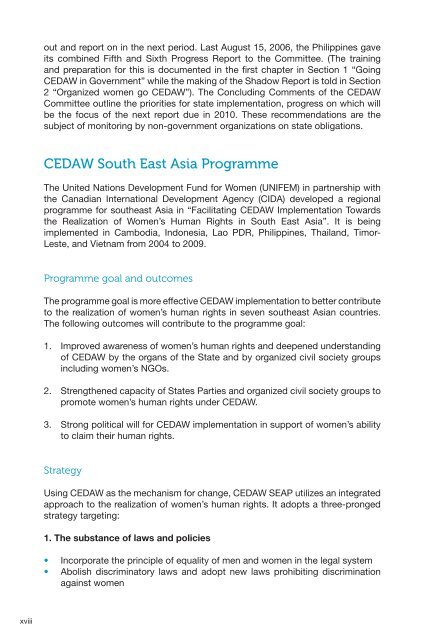Introduction - CEDAW Southeast Asia
Introduction - CEDAW Southeast Asia
Introduction - CEDAW Southeast Asia
- No tags were found...
You also want an ePaper? Increase the reach of your titles
YUMPU automatically turns print PDFs into web optimized ePapers that Google loves.
out and report on in the next period. Last August 15, 2006, the Philippines gaveits combined Fifth and Sixth Progress Report to the Committee. (The trainingand preparation for this is documented in the first chapter in Section 1 “Going<strong>CEDAW</strong> in Government” while the making of the Shadow Report is told in Section2 “Organized women go <strong>CEDAW</strong>”). The Concluding Comments of the <strong>CEDAW</strong>Committee outline the priorities for state implementation, progress on which willbe the focus of the next report due in 2010. These recommendations are thesubject of monitoring by non-government organizations on state obligations.<strong>CEDAW</strong> South East <strong>Asia</strong> ProgrammeThe United Nations Development Fund for Women (UNIFEM) in partnership withthe Canadian International Development Agency (CIDA) developed a regionalprogramme for southeast <strong>Asia</strong> in “Facilitating <strong>CEDAW</strong> Implementation Towardsthe Realization of Women’s Human Rights in South East <strong>Asia</strong>”. It is beingimplemented in Cambodia, Indonesia, Lao PDR, Philippines, Thailand, Timor-Leste, and Vietnam from 2004 to 2009.Programme goal and outcomesThe programme goal is more effective <strong>CEDAW</strong> implementation to better contributeto the realization of women’s human rights in seven southeast <strong>Asia</strong>n countries.The following outcomes will contribute to the programme goal:1. Improved awareness of women’s human rights and deepened understandingof <strong>CEDAW</strong> by the organs of the State and by organized civil society groupsincluding women’s NGOs.2. Strengthened capacity of States Parties and organized civil society groups topromote women’s human rights under <strong>CEDAW</strong>.3. Strong political will for <strong>CEDAW</strong> implementation in support of women’s abilityto claim their human rights.StrategyUsing <strong>CEDAW</strong> as the mechanism for change, <strong>CEDAW</strong> SEAP utilizes an integratedapproach to the realization of women’s human rights. It adopts a three-prongedstrategy targeting:1. The substance of laws and policies• Incorporate the principle of equality of men and women in the legal system• Abolish discriminatory laws and adopt new laws prohibiting discriminationagainst womenxviii
















